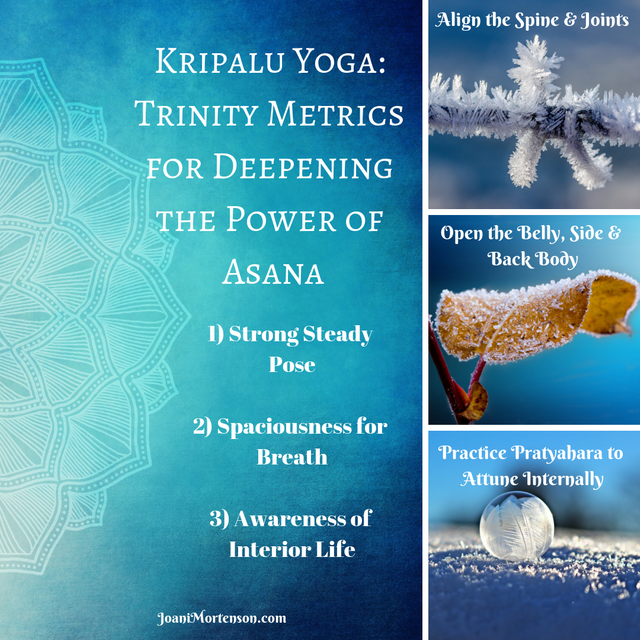A Trinity of Metrics from Kripalu Yoga for Deepening the Power of Asana

This is a post from one of the blogs on my Website: A Deeper Well.
I teach an Introduction to Yoga course in White Rock, British Columbia. This is some information from one of my sessions. In this session we discussed and practiced the Trinity of Metrics from my training in Kripalu Yoga. Kripalu is a Wellness Centre in Stockbridge, Massachusetts that specializes in Yoga, Ayurveda, Nutrition, Outdoor Education and Leadership.
The Trinity of Metrics, or Three Fundamental Skills that mark Kripalu Yoga as a very special expression of Hatha Yoga is the focus on the internal experience during practice. To support this turning within, or phrased another way, coming home to self, is truly what keeps me passionate about this style of practice.
Here is a brief description of the three metrics:
STRONG STEADY POSE
Upon entering into an asana, you are invited to find strength and balance through aligning your joints and ensuring that the spine is not compromised. Pay attention to the muscle groups used in the pose, as research suggests that this attention helps the body to use that muscle with up to 30% more efficiency, simply by focusing. Use only as much energy as needed to hold the pose, and don’t over-hold in areas that are not needed. This will greatly help with the next step.SPACIOUSNESS FOR BREATH
Ensure that there are no impediments to your breath. Lengthen your spine, draw your rib cage up and out of the cauldron of your pelvis. Think about breathing with shape flow; opening your entire torso: front, sides and back, as you breathe deeply through your nostrils. And most importantly, keep your attention on your breath. Attending to your breath keeps you present and sets up the next step.AWARENESS OF INTERIOR LIFE
Once you’ve settled into your asana, holding the pose with ease and supported by your breath, then turn your attention to what is happening inside. Would a micro-adjustment allow a deeper experience? Can you release tension anywhere in your body? How are you feeling? What arises within the life of this pose? Can you accept whatever arises with compassion? Responding to these questions will help you to cultivate something called Interoception, a special kind of awareness of your inner world.
A pathway to the interior world is Pratyahara, or the withdrawal of your senses from the external world so that you may pay closer attention to what is unfolding inside. Pratyahara is the 5th arm of the 8 limbs of yoga as set out by Patanjali. Through pratyahara, we learn to focus less on what is happening around us so that we can divine rich data from inside our bodies.
By practicing the above skills, you will learn to deepen your asana practice, turning it towards a moving meditation. Be patient with yourself while you practice, as this is yoga practice, not yoga perfection.
In-Joy
Reference:
Faulds, R. (2006). Kripalu yoga: A guide to practice on and off the mat. New York, NY: Bantam Books.
I've recently gotten to the point where I can place emphasis / intention on my breath while in my practice, rather than just being confused by what I'm doing and likely holding my breath. All three of these points really resonate quite a bit with my experience, but especially the second one. Not only does it really 'guide the flow' of the practice -- but yes, it absoloutely does help you draw your focus inward and become a bit more aware.
Thank you so much @mstafford for sharing your experience. I always prefer 'experience' over 'authority', especially when considering the body. So happy to hear of others discovering the power of breath. It may sound corny or pithy or trite, but the power of the breath is monumental. Any tools of modernity that help us to resolve stress and tension are so worth exploring. Yours, in radiant health!
Nice one.
I have to write about yoga also soon :-)
The Steemit yogis inspire me 🙏🏼🦋🙌🏽🌸